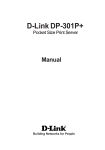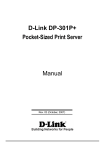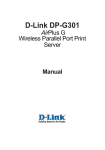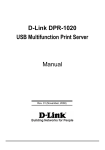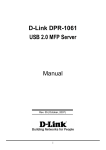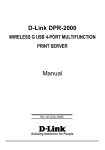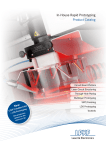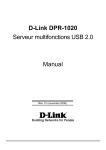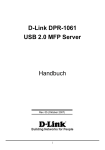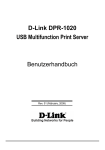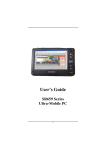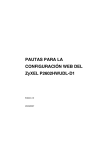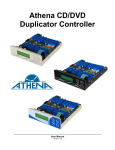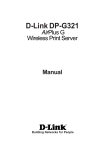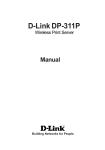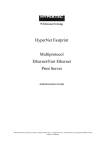Download D-Link DP-300U User's Manual
Transcript
D-Link DP-300U Fast Ethernet Print Server Manual Rev. 01 (November, 2007) Contents Package Contents ......................................................................................... iv Contents of Package: ............................................................................. iv System Requirements: ........................................................................... iv Introduction................................................................................................... 1 External Features.......................................................................................... 3 Port Connectors....................................................................................... 3 Rear Panel...................................................................................................... 4 Network Cable Connector ...................................................................... 4 USB Port Connector ............................................................................... 4 Parallel Port Connector ........................................................................... 4 DC Power Connector .............................................................................. 4 Front Panel .................................................................................................... 5 LED Indicators........................................................................................ 5 Setting up the DP-300U ................................................................................ 6 Installing the Print Server ....................................................................... 6 Power ON Self-Test ................................................................................ 6 Getting Started .............................................................................................. 8 Using PS-Wizard........................................................................................... 9 Auto-Run Installation ............................................................................. 9 PS-Wizard ............................................................................................. 10 Installing PS-Wizard ............................................................................. 10 Using PS-Wizard................................................................................... 14 Using the Web Configuration .................................................................... 20 Home..................................................................................................... 20 SETUP > Print Server Setup................................................................. 22 i SETUP > LAN Setup............................................................................ 24 SETUP > Printer Setup ......................................................................... 25 ADVANCED > Advanced LAN ........................................................... 33 ADVANCED > User Access................................................................. 35 ADVANCED > E-Mail Notification..................................................... 36 ADVANCED > SNMP ......................................................................... 38 MAINTENANCE > Password.............................................................. 39 MAINTENANCE > Save/Restore Settings.......................................... 40 MAINTENANCE > Firmware Upgrade............................................... 41 MAINTENANCE > Diagnostics .......................................................... 42 STATUS > Device Info......................................................................... 43 STATUS > Network.............................................................................. 45 STATUS >Print Log.............................................................................. 47 HELP .................................................................................................... 48 Reboot................................................................................................... 49 Refresh Printer Status ........................................................................... 50 TCP/IP Printing for Windows Vista.......................................................... 51 TCP/IP Printing for Windows XP ............................................................. 63 TCP/IP Printing for Windows 2000 .......................................................... 76 TCP/IP Printing for Windows 98SE/ME .................................................. 94 Unix/Linux Printing.................................................................................. 107 Printing Text Files form Unix ............................................................. 107 Printing form BSD Unix Versions ...................................................... 108 Printing from SCO Unix System V/386 ............................................. 111 Printing from Solaris........................................................................... 113 Printing from Red Hat Linux .............................................................. 114 Setting up Printing in Mac OS X Tiger (10.4) ........................................ 121 ii Adding a Printer.................................................................................. 123 AppleTalk-enabled or Bonjour-enabled Printers ................................ 125 Setting up AppleTalk or LPR Printing in Mac OS X ............................ 135 Setting up AppleTalk Printing in Mac OS 9 ........................................... 140 Technical Specifications............................................................................ 145 Appendix: DP-300U Printer Compatibility List .................................... 146 iii Package Contents Contents of Package: D-Link DP-300U Print Server Manual and Warranty on CD Printed Quick Installation Guide If any of the above items are missing, please contact your reseller. System Requirements: A computer with an installed Ethernet adapter Windows Vista/XP/2000/NT4/ME/98SE/95 Apple Mac OS 9.x to MAC OS X 10.4.x Linux, Solaris, SCO Unix, AIX Internet Explorer 6.0 or above; Netscape Navigator version 6.0 or above, with JavaScript enabled Printer must support required operating system iv Introduction The D-Link DP-300U Print Server is print server that connects to your Ethernet/Fast Ethernet network anywhere you wish to locate printer services. The DP-300U manages the flow of print files from workstations or file servers to connected printers, delivering print jobs to printers much faster than a file server or a PC acting as a print server can. The DP-300U includes easy-to-use software to install on most Windows-based networks. Protocol support for TCP/IP, NetBEUI, and AppleTalk are provided to ensure seamless connection to major networking Operating Systems. The DP-300U has a built in Web-Based management feature that allows users to easily configure and manage multiple print queues through TCP/IP. The DP-300U also supports Telnet as an alternative method to configure the unit. The DP-300U improves network printing services in the following ways: The DP-300U picks up the workload of managing print file traffic to its connected printers. This provides workload relief to your file servers, and allows the file servers full capacity to be used for file access or other direct services to network users. On peer-to-peer networks, workstations can print directly to the Print Server without increasing the load of another workstation or server. The DP-300U’s two parallel printer ports are IEEE1284-compliant high-speed bi-directional port and its USB printer port is USB 2.0 port, which can transmit to high-speed laser printer much faster than a PC’s parallel/USB printer port. High-speed laser printer connected to the Print Server’s parallel/USB port can be operated at their full capacity. 1 Because the DP-300U is very portable and inexpensive compared to a PC-based print server, and Print Server connects to your file servers through the network, printers can be deployed to locations of maximum convenience to users. The DP-300U offers extraordinary flexibility, operating with all major network operating systems and protocols: TCP/IP UNIX lpr/lpd (HP-UX, SunOS, Solaris, SCO, UnixWare, IBM AIX) Windows NT/2000, Windows 95/98SE/ME, Windows XP/Vista, NetWare 5.x NDPS LPR Remote Printing NetBEUI Windows NT/2000/XP, Windows 95/98SE/ME, Windows for Workgroups, Microsoft LAN Manager, IBM LAN Server AppleTalk MacOS EtherTalk Furthermore, the print server features a useful software: PS-Wizard. PS-Wizard is a user-friendly program used to complete further settings for the print server, and assists you to easily add a printer on your computer. See also the “Using The PS-Wizard” chapter in this manual for the details. The print server also supports configuration and management via the Telnet protocol for networks without Windows-compatible machines. 2 External Features Port Connectors The DP-300U has two parallel ports and one USB port located on its back panel. The ports are configurable using the Web Configuration Interface or the print server’s Telnet interface. The Print Server’s Web configuration permits users to configure settings through the web browser. Default IP Address of DP-300U is set as automatically getting from DHCP server or Router which build-in DHCP server. NOTE: The PC’s IP Address must be in the same subnet as the print server’s IP Address for the two devices to communicate. (For example, if print server’s IP Address is 192.168.0.10, with a subnet mask of 255.255.255.0, then your computer’s IP Address should be 192.168.0.x, where x is a value between 1-254, excluding 10.) 3 Rear Panel DC Power Connector USB Port Connector Network Cable Connector Parallel Port Connector Network Cable Connector The Print Server’s rear panel features an RJ-45 connector for connection to 10Base-T Ethernet cabling or 100Base-TX Fast Ethernet cabling (which should be Category 5 twisted-pair cable). The port supports the NWay protocol, allowing the Print Server to automatically detect or negotiate the transmission speed of the network. USB Port Connector The rear panel of the print server features the USB port connector. Plug this connector directly into the USB port on your network printer via a USB cable. Parallel Port Connector The rear panel of the print server features two parallel port connectors. Connect this port to the parallel port on your network printer with a parallel cable. DC Power Connector The DC power input connector is located on the Print Server’s rear panel and is labeled DC 5V. 4 Front Panel LED Indicators The front panel of the print server features five LED indicators: LED Indictors Power Steady green confirms that the Print Server is powered ON. Link/Act Steady green confirms that the Print Server has a good connection to the Ethernet or Fast Ethernet network. The indicator blinks off briefly to indicate that the Print Server is receiving or transmitting from the network. USB Lights up to indicate printing activity. LPT1/LPT2 Lights up to indicate printing activity. These five indicators are also used by the Print Server’s Power-ON Self Test (POST) to indicate any hardware failures. 5 Setting up the DP-300U Installing the Print Server WARNING: Configuration problems may result if the Print Server is powered up without first establishing its network connection. Follow this procedure to avoid complications at the configuration stage. 1. Confirm proper operation of the printers to be connected to the DP-300U. 2. When you have confirmed proper operation of the printer, switch its power OFF. 3. Confirm that your network is operating normally. 4. Connect the DP-300U RJ-45 Connector to the network, using an Ethernet CAT5 cable. 5. While the printer is powered OFF, install the corresponding parallel or USB printer cable to connect the printer’s parallel port or USB port to the printer port of the Print Server 6. Switch on the connected printer. 7. Plug the AC power adapter’s DC output plug into the DC 5V power socket on the rear panel of the Print Server. 8. Plug the power adapter into a power outlet. This will supply power to the Print Server, as it has no external power switch. The green Power LED on the Print Server’s front panel should illuminate steadily, and the Print Server’s Self-Test will proceed. Power ON Self-Test Every DP-300U has been factory-tested to operate properly. When the DP-300U is powered ON, it also automatically performs a Self-Test on each of its major components. The final result of the Self-Test is signaled by the state of the LPT/USB LED indicator following the Self-Test. Preliminary to the actual component tests, the five LED indicators are tested to confirm their steady 6 and flashing operation. Immediately after power-up, all five of the green LEDs should illuminate steadily for several seconds. Then the LPT1, LPT2 and USB LED indicators should light OFF. Irregularity of any of the three LEDs during these LED tests may mean there is a problem with the LEDs themselves. The actual component tests immediately follow the LED tests. A normal (no fault) result is signaled by a simultaneous flashing of the LPT/USB LED three times, followed by a quiescent state with the LPT/USB LED dark. If the Self-Test routine traps any component error, then following the LED tests the Self-Test will halt and the LPT/USB LED will continuously signal the error according to the following table. In the event of any such error signal, contact your dealer for correction of the faulty unit. LPT/USB LED Faulty Component On DRAM error 1 long 3 short Flash Protected 1 long 5 short Flash Erase/Program error 1 long 6 short LAN Controller error 1 long 8 short LPT Controller error 1 long 9 short LPT error 1 long 14 short LAN MII error 1 long 18 short USB error 1 long 19 short PCI error 7 Getting Started Below is a sample network using the DP-300U. The DP-300U has a built- in Web-based management feature that allows users to easily configure and manage multiple print queues through TCP/IP. For a list of printers that are compatible with the DP-300U, please see the Appendix in this manual. The compatibility list is not comprehensive. Even if it is not included in the list, your printer may be compatible with the DP-300U. 8 Using PS-Wizard This chapter will introduce you the installation and operation of a useful software program – PS-Wizard. Auto-Run Installation Insert the Installation CD-ROM into your computer’s CD-ROM drive to initiate the Auto-Run program. The content of the Installation CD-ROM includes: y View Quick Installation Guide - click to preview the Quick Installation Guide in PDF format for step-by-step instructions of the print server Installation. • View Manual – click to preview the User's Guide in PDF format for detailed information of the print server. • Install Acrobat Reader – click to launch Acrobat Reader for the viewing and printing of PDF files in the Installation CD-ROM. • Install PS-Wizard – click to install PS-Wizard to complete further settings for the print server, such as: - Changing IP address - Adding a printer on your computer in the easiest way. • Close – click to close the Auto-Run program. 9 PS-Wizard To avoid the conflict in your network, you can use PS-Wizard to change the related settings of your print server (such as the IP address) after finishing the installation of PS-Wizard on your PC. Installing PS-Wizard 1. Click the PSWizardSetup icon of the Installation CD-ROM, and then the system will prompt a window for you to select a desired setup language from its pull-down list. After done the selection of language, click OK to continue. 10 2. Click Next> in the welcome window of InstallShield Wizard. 3. Specify the destination location by clicking the Browse… button. leave the default setting and click Next> to continue. 11 Otherwise, 4. You may enter a new folder name in the Program Folder field if you want to change the default name. Otherwise, you may leave the default setting and click Next> to go on the installation. 12 5. The InstallShield Wizard starts to install the software, and the Progress bar indicates the installation is proceeding until the following window shows up. Click Finish to complete the installation. After installing the program, the application program for the print server is automatically installed to your computer, and creates a folder in StartÎ ProgramsÎ PS-Wizard. 13 Using PS-Wizard PS-Wizard, supports for Windows 2000/XP/2003/Vista, is a simple and useful tool for you easily adding a printer on your computer in order to quickly start your printing task without any complicated configuration. That is, the main goal and advantage of the PS-Wizard is to let you add a printer on your PC in the easiest way. Furthermore, the PS-Wizard also allows you to set up IP addresses of print server, such as IP address, Subnet Mask address, and default Gateway address. Go to StartÎ ProgramsÎ PS-Wizard, and select PS-Wizard. 14 Print Server: This field allows you to manually discover the connected print server and to do further configuration of the print server that is selected from the list. 15 LAN: You may also to specify dynamic or static IP address for your print server. Then click Apply button to implement the new setting. Port Information: This is the main function of the PS-Wizard for you to easily add a printer on your computer. To add a printer, click , then the following window will display. 16 The wizard provides three ways for you to select printer driver: 1. Show current installed drivers: You may select this option, “Show currently installed drivers”, to check if the same printer driver already existed for use. If not, you may try the next method. After done the selection of printer driver, click Next> button to continue. 2. Select from manufacturer list: Check this option, “Select from manufacturer list”, to manually select your printer from drop-down menus by brand and model. Click Next> to continue when you find a desired driver. If not, try the last way (Have Disk). After done the selection of printer driver, click Next> to continue. 3. Have Disk: Click Have Disk to bring up the following window. Insert the manufacture’s installation CD-ROM to install the printer driver. After the correct driver is selected, click OK to continue. After selecting the printer driver, the wizard will ask you to confirm your selection again in the following window. Beside, you are allowed to edit the name of the 17 printer in the Network Printer Name box and enable this printer as the default printer by checking the Use this printer as the default printer for Windows-based programs box. After you did the verification and configuration in the following window, click Next> to continue. Then the printer (e.g. HP Laser 2000 used in this manual) will be auto-created in Printers and Faxes as the following illustration. 18 When the following window shows up, you may do print test by clicking the Print Test Page to check if you can do printing normally. If yes, click Finish to exit the installation window and now you may start your printing tasks. 19 Using the Web Configuration Home To begin managing the DP-300U, simply launch the browser (e.g. Internet Explorer 6.0 used in this manual) you have installed on your computer and direct it to the URL address: dlink-xxxxxx, where xxxxxx are the last six digits of DP-300U’s MAC address. The MAC address can be found on the bottom side of the DP-300U device. When you enter the correct URL, a password input dialog will pop up the following screen. Type “admin” in the User name box, leave the Password box as blank, and then click OK. Then the main screen of the print server’s configuration will appear (see below). In addition to the product information, you can access and control the print server’s 20 configuration through five links on the top of this main screen: Setup, Advanced, Maintenance, Status, and Help. You may click a desired link from the bar, to display its submenu and select a desired option listed in the left column, and then the corresponding content will show up in the center column. 21 SETUP > Print Server Setup The Print Server Setup screen allows you to modify the Print Server Name and Port Settings, as below shows. D-Link does not recommend changing these settings unless asked by your network administrator. 22 Print Server Name In this field, you can configure the basic information of print server. The basic information contains a name of the print server, assigned in Server Name box, and a location for the print server, assigned in Location (optional) box. Port Settings In this field, you can assign the Port Name for the print server, and the description for the Printer port. It also allows you to select the PJL Printer setting (Yes or No). NOTE: PJL (Printer Job Language) has certain job requirements that must be met to work correctly. For more information, please refer to your printer's manual. Once you have changed the settings in each option, click Apply Settings to store the settings, or Cancel to abandon. 23 SETUP > LAN Setup The LAN Setup screen allows you configure the local network settings of print server. Please note that this section is optional and you should not need to change any of the settings here to get print server up and running. TCP/IP This field allows you to assign IP address in manual or automatic method. When you choose Manually Assign, you should enter the related information in the following boxes, including IP Address, Subnet Mask, and Default Gateway. Once you have changed the settings in each option, click Apply Settings to store the settings, or Cancel to abandon. 24 SETUP > Printer Setup The Printer Setup screen allows you install the printer drivers for the printer currently connected to your print server. Network Printer Wizard Click Next to download and run a windows wizard program to install a network printer onto your computer. When you click Next, you will be asked to download and run some software. 25 The above screen is the Network Printer Wizard. Click Run, and if a second window appears as below click Run again. Select the printer required, and then click Next to continue. 26 The wizard provides three ways for you to select printer driver: 1. Show current installed drivers: You may select this option, “Show currently installed drivers”, to check if the same printer driver already existed for use. If not, you may try the next method. After done the selection of printer driver, click Next> to continue. 27 2. Select from manufacturer list: Check this option, “Select from manufacturer list”, to manually select your printer from drop-down menus by brand and model. Click Next> to continue when you find a desired driver. If not, try the last way (Have Disk). After done the selection of printer driver, click Next> to continue. 28 3. Have Disk: Click Have Disk to bring up the following window. Insert the manufacture’s installation CD-ROM to install the printer driver. After the correct driver is selected, click OK to continue. 29 After selecting the printer driver, the wizard will ask you to confirm your selection again in the following window. Beside, you are allowed to edit the name of the printer in the Network Printer Name box and enable this printer as the default printer by checking the Use this printer as the default printer for Windows-based programs box. After you did the verification and configuration in the following window, click Next> to continue. Then the printer (e.g. HP Laser 2000 used in this manual) will be auto-created in Printers and Faxes as the following illustration. 30 When the following window shows up, you may do print test by clicking Print Test Page to check if you can do printing normally. If yes, click OK to close the PS-Wizard dialog box. If yes, then click Finish to exit the installation window and now you may start your printing tasks. 31 32 ADVANCED > Advanced LAN The Advanced LAN screen allows you to further network setting of print server. It is not recommended not to change the settings unless instructed to modify the setting by your network administrator. The Advanced LAN screen contains these fields: TCP/IP, Microsoft Network, and AppleTalk. 33 TCP/IP This field contains four options that allow you to configure the TCP/IP setting: DNS Server Address, UPnP, Mac Bonjour/Rendezvous, and Second HTTP Port. UPnP: This option allows you to enable or disable UPnP function. Mac Bonjour/Rendezvous: This option allows you to enable or disable Mac Bonjour/Rendezvous function. Second HTTP Port: This option allows you to enable or disable Second HTTP Port for remote Web Configuration and IPP Printing. Microsoft Network Enter the name of the Workgroup that you want the print server associated with in this field. AppleTalk Enter the AppleTalk Zone name in the box. In the following options, enter the related configuration, such as the printer type. Chooser Name: Display the print server's port name. Printer Type: Enter the printer's type in this box. PostScript Level: Select from the drop-down list (Level 1 or Level 2). Font Group: Select from the drop-down list. Once you have changed the settings in each option, click Apply Settings to store the settings, or Cancel to abandon. 34 ADVANCED > User Access The User Access screen allows you to create and maintain an authorized list of users that are allowed to access the print server. User Access By configuring the Enable Authorised User List option (Yes), the user in the User List is permitted to access the print server. Any user who is not added in the User List will not be allowed to access the print server. Once you have changed the settings in each option, click Apply Settings to store the settings, or Cancel to abandon. Authorised Users You can add or delete any user to or from the User List at the bottom of the screen. It displays the current defined user and related information for the print server. 35 ADVANCED > E-Mail Notification The E-Mail Notification screen allows you to assign an e-mail address to the print server, so that your mail of the account can be printed out directly through the printer (ASCII text only). This screen also allow you choose where to send an email when the printer status changes. 36 Enable E-mail Notification You can set the print server to send an alert message when the printer status changes through e-mail. To enable this function, click Yes in Enable e-mail notification. Then, input the administrator's e-mail address in the Destination e-mail Address box. E-mail Account Details You can assign an e-mail address to the print server, so that your mail of the account can be printed out directly through the printer (ASCII text only). To enable this function, enter the e-mail account in the Print Server E-mail Address box. Then, enter the server address, used to receive your e-mail in the Incoming E-mail (POP3) Server Address box. For Outgoing E-mail (SMTP) Server Address field, enter the server address that is used to send your e-mail. If your mail server needs to verify the user when sending e-mail, Print Server will apply the E-mail Account (POP3) Name and E-mail Account (POP3) Password to the mail server. E-mail Printing (To LPT1 Port) This section is for you to do e-mail Printing configuration, including: E-mail Printing (ASCII Text Only): Allows you to enable or disable the E-mail printing. Check E-mail Interval: Allow you to set up a time interval in minute in order to check/receive E-mail periodically. After done the configuration, click Apply Settings to restore the new configuration, or Cancel to abandon. 37 ADVANCED > SNMP The SNMP screen allows you to use SNMP (Simple Network Management Protocol) to manage complex networks. SNMP Management Community 1/2/3: Enter a name in the Name box, and configure the Access Right by selecting Read Only or Read/ Write from the drop-down list. 38 MAINTENANCE > Password The Password screen allows you to change the password of the print server by entering the current password in Current Password and new password in New Password and Confirm Password. After done the configuration, click Apply Settings to enable and restore the new password, or Cancel to abandon. Be aware that the default password of the print server is blank. 39 MAINTENANCE > Save/Restore Settings The Save/Restore Settings screen not only allows you to save the current configuration in a computer for backup by clicking Save in Save Settings to Local Hard Drive, but also allows you to reload a configuration that you saved before by clicking Browse to direct to the backup file, and then clicking Update Settings for reloading. Beside, you are also allowed to return the print server to the default settings by clicking Restore Device in Restore to Factory Default Settings. 40 MAINTENANCE > Firmware Upgrade The Firmware Upgrade screen displays you the current firmware’s information of the print server, and also allows you to upgrade the firmware of the print server when a new version of firmware is available. Click Browse to point to the firmware file, and then click Upgrade. 41 MAINTENANCE > Diagnostics The Diagnostics screen allows you to test the printing for LPT/USB port of the print server. After selecting a port, click Print Test Page to print a test page. 42 STATUS > Device Info The Device Info screen displays the status of your print server, printer, and network for your reference. 43 Print Server Status This field displays the information of the print server about the firmware version, MAC/IP address, and up time. Printer Status The items in this field display the information of the printer, such as the given name for the printer, speed, printer status, and status of your printing tasks, etc. LAN Status You can monitor the networking status in this field, including the network connection, speed, and the packets status. 44 STATUS > Network The Network screen displays the general Network status of your print server. 45 Auto IP This field contains the current settings of TCP/IP, including DHCP/BOOTP, UPnP, and Mac Bonjour/Rendezvous. The items in this field are configured in Advanced Æ Advanced LAN Æ TCP/IP. TCP/IP Printing In this field, you can monitor the status of your printing tasks through TCP/IP. Microsoft Network Printing In this field, you can monitor the status of your printing tasks through Microsoft Network. Mac AppleTalk Printing In this field, you can monitor the status of your printing tasks through Mac AppleTalk. 46 STATUS >Print Log The Print Log screen displays the printing record of the authorized users. Print Log The items in this field display the user(s) information, which include the user(s) MAC address, IP address, name, and status of printing tasks. 47 HELP The Help screen provides you brief information about the print server for your reference. 48 Reboot If you want to reset the print server, you may just click Reboot for restarting. 49 Refresh Printer Status Click a port name to refresh the status of the connected printer. 50 TCP/IP Printing for Windows Vista Go to Start Î Control Panel Î Printers. 51 Click Add a printer. Select the first option, Add a local printer, and then click Next. 52 Select the second option, Create a new port, and highlight Standard TCP/IP Port from the pull-down menu. Click Next. 53 Type the IP address of the print server (e.g. 10.62.31.15 used in this manual), which can be referred from the PRINTER SERVER STATUS of the print server’s Web configuration, and then the Port Name will automatically be filled in. Click Next 54 55 Select Custom and click Settings. Then the follow screen will shows up, select LPR from the Protocol field. Then enter the Queue Name, which can be referred from PRINTER STATUS of the print server’s Web configuration, in the LPR Settings field. Click OK. 56 57 58 Highlight the printer, as shown. If the desired printer is not on the list, click Have Disk and insert the printer driver disk that came with your printer to install the printer drivers. Click Next 59 Click Next. 60 After clicked Print a test page, a small dialogue box will show up as below. Click Close. 61 Click Finish. The printer is now ready for printing with Windows Vista on your network. 62 TCP/IP Printing for Windows XP Go to Start Î Printers and Faxes Î Add a Printer. When the following screen shows up, click Next. 63 Select the first option, Local printer attached to this computer, and click Next. 64 Select the second option, Create a new port, and highlight Standard TCP/IP Port from the pull-down menu. Click Next. 65 Type the IP address of the print server (e.g. 10.62.31.15 used in this manual), which can be referred from the PRINTER SERVER STATUS of the print server’s Web configuration, and then the Port Name will automatically be filled in. Click Next 66 67 Select Custom and click Settings. 68 Then the follow screen will shows up, select LPR from the Protocol field. Then enter the Queue Name, which can be referred from PRINTER STATUS of the print server’s Web configuration, in the LPR Settings field. Click OK. 69 70 Click Next. 71 Click Finish. 72 Highlight the printer, as shown. If the desired printer is not on the list, click Have Disk and insert the printer driver disk that came with your printer to install the printer drivers. Click Next At this screen, you can input a name for the printer, and then click Next 73 Select Yes to print a test page, click Next. 74 Click Finish. The printer is now ready for printing with Windows XP on your network. 75 TCP/IP Printing for Windows 2000 Go to Start Î Settings Î Printers and Faxes Î Add a Printer. 76 When the following screen shows up, click Next. 77 Select the first option, Local printer attached to this computer, and click Next. 78 Click Next. 79 Select the second option, Create a new port, and highlight Standard TCP/IP Port from the pull-down menu. Click Next. 80 Click Next. 81 Type the IP address of the print server (e.g. 10.62.31.15 used in this manual), which can be checked from the PRINTER SERVER STATUS of the print server’s Web configuration, and then the Port Name will automatically be filled in. Click Next 82 83 Select Custom and click Settings. 84 Then the follow screen will shows up, select LPR from the Protocol field. Then enter the Queue Name, which can be referred from PRINTER STATUS of the print server’s Web configuration, in the LPR Settings field. Click OK. 85 86 Click Next. 87 Click Finish. 88 Highlight the printer, as shown. If the desired printer is not on the list, click Have Disk and insert the printer driver disk that came with your printer to install the printer drivers. Click Next. 89 At this screen, you can input a name for the printer, and then click Next 90 Select the first option, Do not share this printer, and click Next. 91 Select Yes to print a test page, click Next. 92 Click Finish. The printer is now ready for printing with Windows 2000 on your network. 93 TCP/IP Printing for Windows 98SE/ME Go to Start Î Settings Î Control Panel. Double click on Network, and then click Add. 94 Highlight Client and click Add. At this window, click Have Disk. 95 1. Insert the DP-300U CD-ROM into your CD-ROM drive. Select the letter representing the CD-ROM drive on your computer from the pull-down menu. 2. Double-click on the folder lpr. 3. Highlight lpr.inf 4. Click OK. Click OK to accept the location of the file. 96 You should now be back to the Network Properties Page. Highlight LPR for TCP/IP Printing and click Properties. 97 Click Add Port. Type in the IP address and Port Name of the print server, which can be referred from the PRINTER SERVER STATUS and PRINTER STATUS of the print server’s Web configuration, in the corresponding field, and then click OK. (The IP Address and Port Name here are just for example only.) 98 99 The IP Address and Port Name will be displayed in the following screen. (The IP Address and Port Name here are just for example only.) Click OK. 100 Click OK. Windows will ask for a restart. Click Yes. 101 Once your computer has rebooted, click on Start Î Settings Î Printers Î Add Printer. When the Add Printer Wizard screen appears, click Next. Select Network Printer and click Next. 102 Type in the path if you know it; otherwise, click Browse. At the following screen, browse for the printer port and highlight the port (e.g. dlink-1D6FA3 in this manual). Click OK. 103 If the network path is not specified, type in the IP Address and Port Name of the print server. Select Yes or No to enable or disable printing from MS-DOS based programs. Click Next. 104 Highlight the printer, as shown. If the desired printer is not on the list, click Have Disk and insert the printer driver disk that came with your printer to install the printer drivers. Click Next. Click Next 105 Select Yes to print a test page. Click Finish. To check whether the printer is installed, go to Start Î Settings Î Printers. 106 Unix/Linux Printing Printing Text Files form Unix Text files on Unix systems contain lines that end with “newline” characters, as opposed to MS-DOS and Windows-related operating systems that end with a carriage return followed by a linefeed. Most printers require a carriage return/linefeed pair at the end of each line, making it necessary for some translation to be done before Unix text files can be printed on most printers. For this purpose, you can define two “printers” for the same printer port, one that prints to the port itself, and one that prints to the port name with _TEXT added to the name. Files printed to the second port will be translated so that the printer has the carriage return/linefeed pairs that it needs. For example, you could define a printer hp5l that prints to port PS-142634-P1, and a printer hp5lt that prints to port PS-142634-P1_TEXT. Your graphics files could then be printed to the hp5l printer, and “raw” text files could be printed to the hp5lt printer. 107 Printing form BSD Unix Versions For “flavors” of the Unix operating system derived from or related to the BSD releases, such as SunOS 4.x, Linux, BSD/OS, FreeBSD, or NetBSD, you can use the following procedure to enable users to print to a printer connected to your D-LINK network print server: 1. Log in as the superuser (root). 2. Add an entry for the print server in the host’s /etc/hosts file, giving a hostname for the print server’s IP address. A line in /etc/hosts contains an IP address and one or more aliases for the host . For example: 202. 39. 74. 40 ps-142634 ps-142634.dlink.com.tw If you use DNS (the Domain Naming Services protocol), you can add an address record entry to your DNS database for the print server. 3. Create a spool directory for the printer: ◊ On SunOS systems, create the directory as a subdirectory of /var/spool, with the same name as the printer (e.g., /var/spool/hp5l ). ◊ On Linux systems, create the directory as a subdirectory of /user/spool /lp. ◊ On BSD/OS, FreeBSD, or NetBSD systems, create the directory as subdirectory of /var/spool. 4. Change the owner and permissions of the directory so that it is owned and writable by group daemon, using the following commands: chown bin.daemon /var/spool/hp5l chmod 775 /var/spool/hp5l 108 5. Add an entry for the printer to /etc/printcap, similar to the following: hp5l:\ :lp=:sd=/var/spool/hp5l :mx#0:\ :rm=ps-142634:rp=ps-142634-p1: The meaning of each of the entries is described below. The directory path in the sd spool directory entry should match the directory name you created above. If your entry requires more than one line you can escape the newline with a backslash. 6. Issue the command lpc start hp5l to start a spool daemon for the printer. The printer will now be available for use. 7. Optionally, add another printcap entry (and issue another lpc start command) for a second printer, using the port_TEXT port. This second printer name can be used for printing text files. Entries in /ect/printcap begin with a name for the printer or a list of name, separated by | (a vertical bar). The entries used above are: ◆ lp= The lp entry is used to specify a local printer device. Since the printer is a remote printer, this entry should be blank. ◆ sd=dir The location of the printer’s local spool directory. ◆ mx#blocks The limit for print job files in the local spool directory; 0 means no limit. 109 ◆ rm=address The host where the remote printer is located, in this case the D-Link print server. ◆ rp=printer The name of the printer on the remote host. For the D-Link print server, the port name should be used. Note: this entry is case-sensitive. 110 Printing from SCO Unix System V/386 To allow printing to a printer attached to your D-LINK network print server from a SCO Unix System V/386 host. 1. Login as the superuser (root). 2. Add an entry for the print server in the host’s /etc/hosts file, giving a hostname for the print server’s IP address. A line in /etc/hosts contains an IP address and one or more aliases for the host. For example: 202.39.74.40 ps-142634 ps-142634.dlink.com.tw If you use DNS (the Domain Naming Services protocol), you can add an address record entry to your DNS database for the print server. 3. Change to the /dev directory, and issue the command mkdev rlp 4. The script will ask: Do you want to install or delet remote printing (i/d/q)? Answer i and press Enter to continue. 5. The script will ask: Do you want to change the remote printer description file /etc/printcap (y/n)? Answer y and press Enter to continue. 6. The script will ask: Please enter the printer name (q to quit): Enter an alias for the printer on the local machine and press Enter. This name should be the same as the destination port name. 111 7. Answer r (remote printer) to the question Is printer a remote printer or a local printer (r/l)? 8. When prompted with the question: Please enter the name of the remote host that printer is attached to: then enter the address of the D-Link print server. You can use the name you added to /etc/host in the step above. 9. Confirm that your entries are correct. Is this correct? (y/n) 10. Answer the question: Would you like this to be the system default printer? (y/n) 11. When you are done adding remote printers, enter q for the printer name. 12. Answer y to the question Do you want to start remote daemon now (y/n)? Once remote printing is set up, you can use the lp command to print jobs to the new printer. For more information, consult your SCO Unix documentation. 112 Printing from Solaris To allow printing from a Sun Solaris workstation, 1. Log in as the superuser (root). 2. Add an entry for the print server in the host’s /etc/hosts file, giving a hostname for the print server’s IP address. A line in /etc/hosts contains an IP address and one or more aliases for the host . For example: 202.39.74.40 ps-142634 ps-142634.dlink.com.tw If you use DNS (the Domain Naming Services protocol), you can add an address record entry to your DNS database for the print server. 3. In OpenWindows, start the admintool program. 4. Click on the Printer Manger icon. 5. From the Edit menu, select Add Print, then Add Access to Remote Printer… 6. Enter values for the fields as follow: ◊ Printer Name This field should contain the name of the printer port you wish to use. The field is case-sensitive. ◊ Printer Server This field should contain the IP address of the print server, or the alias name you added in step 2. ◊ Printer Server OS This field should be set to BSD. 7. Confirm the addition. 8. Optionally repeat the addition to add another printer for printing text files, with_TEXT appended to the port name. Once you have added the new printer, you can use the lp command to print files to the printer. Consult your Solaris documentation for details. 113 Printing from Red Hat Linux Adding a Printer 1. Click the printer icon at the bottom of the desktop. 2. Since no printer is set up so far, a prompt appears asking to run the printer configuration tool. 3. Click the OK button in the pop-up dialogue box to open the man Printer 114 configuration tool menu. Note that to use the Printer configuration tool you must have root privileges, and to start the application you may also type the command: “redhat-config-printer”. 4. Click the New button in the Printer configuration tool menu. Printer Configuration Tool menu 115 5. The Add a new print queue menu appears, click Forward to continue. 116 6. Enter a unique name for the printer in the Name text field. The printer name cannot contain spaces and must begin with a letter. The printer name may contain letters, numbers, dashes (-), and underscores (_). Optionally, enter a short description for the printer, which can contain spaces. Then click Forward to enter Queue type window. 7. Select Networked UNIX (LPD) in the Select a queue type pull down menu, enter the IP address of the print server to which the printer is attached in Server field, and type the port name in queue field. Click Forward to select the type of printer. 117 8. Select the printer model. 118 If a printer has not been detected automatically, select the model from the list. You can manually select the name of the printer manufacturer from the Generic (click to select manufacturer) pull-down menu, and the printer model from the sub-list. Click Forward to continue. 9. The last step is to confirm your printer configuration. Click Apply button to confirm or Back button to modify the configuration. 119 10. Print a test page to make sure the printer is functioning properly. To print a test page, select the printer from the printer list, then select the appropriate test page from the Test drop-down menu. 120 Setting up Printing in Mac OS X Tiger (10.4) NOTE: Mac OS printing is supported by Postscript printers only! With Mac OS X Tiger (10.4), you can use Apple Talk, Bonjour, Internet Printing Protocol (IPP), Line Printer Daemon (LPD), and HP Jet Direct-Socket printing through Print Server. Click on this icon in your Dock to open your System Preferences window as below. Click on the Network icon in System Preferences menu to view the menu below. Select the Apple Talk tab in the Network menu. Check to select the Make Apple 121 Talk Active option. Click on the Apply Now button and close the menu. Apple Talk is now active on the system. Now a printer can be added. 122 Adding a Printer Use the Go menu at the top tool bar and select Applications option and find the Utilities folder or open the Utilities folder directly in Go menu. In the Utilities folder, find and select to open Printer List window. If no printer has been set up on your Macintosh, you will be prompted to add a printer. Click Add button on the pop-up dialogue box to open Printer Browser window. 123 Mac OS X Tiger (10.4) supports five printing protocols: 1. AppleTalk 2. Bonjour 3. Internet Printing Protocol (IPP) 4. Line Printer Daemon (LPD) 5. HP Jet Direct – Socket To add an Internet Printing Protocol enabled, Line Printer Daemon enabled or HP button and follow the Jet Direct – Socket enabled printer, click on the instructions to add an IP Printer beginning on “Adding an IP printer” session. 124 AppleTalk-enabled or Bonjour-enabled Printers To add an AppleTalk-enabled or Bonjour-enabled printer, click on the button in the Printer Browser menu. Select the printer model from Printer Name list and Connection type in the Printer Browser menu. The printer name selected should be the same as that appearing listed in the Printer Server’s web manager. In the example here, the printer name is dlk-1A2AAA-P1. By default the Printer Browser will use the Auto Select for Print Using: to determine what printer configuration to use. This may also be manually selected in the Print Using drop-down menu by brand and model. Click the Add button to exit the Printer Browser window and implement the new setting. 125 The printer that has just been added will show up in the Printer List menu, it might take a few seconds depending on network conditions. When the printer 126 appears listed it is ready for use. Quite the Printer Setup Utility and start printing. 127 Adding an IP Printer To add an Internet Printing Protocol enabled, Line Printer Daemon enabled or HP Jet Direct – Socket enabled printer, click on the IP Printer button in the Printer Browser window. Select the desired printing protocol from the Protocol drop-down menu. Type the IP Address of the printer, the name will appear in the Name field when the printer is found. The Printer Browser will indicate that it is verifying the address. If the printer is found, the Printer Browser will state “Valid and complete address” under the Address field. The printer utility is able to detect the printer and may automatically select the 128 correct printer driver in the Print Using field. Or manually select the printer-maker from the Print Using drop-down menu, and then select the printer model from the scroll-down list, or select Generic PostScrip Printer option from the Print Using drop-down menu if the model is not listed. To implement the setting, click Add button. The setup procedures for these three printing protocols (Internet Printing Protocol (IPP), Line Printer Daemon (LPD), and HP Jet Direct – Socket) are basically the same. Illustrated examples are include below for the sake of reference. 129 For set up LPD Printing: 1. Enter the IP address of the print server to which the printer is attached in Address field. 2. Type the port name in queue field. Click Add button after done the section of printer model in the Print Using drop-down menu. 130 For set up IPP Printing: 1. Enter the IP address of the print server to which the printer is attached in Address field. After that, type “: 80” or “: second port” if print server’s second port is enabled. 2. Type the port name in queue field. Click Add button after done the section of printer model in the Print Using drop-down menu. 131 For set up Socket Printing: 1. Enter the IP address of the print server to which the printer is attached in Address field. After that, type “: 9100” for port 1, “: 9101” for port 2 or “: 9102” for port 3. 2. Keep the blank in queue field. Click Add button after done the section of printer model in the Print Using 132 drop-down menu. When the Installable Options pop-up window shows up as below, click Continue button. 133 The printer that has just been added will show up in the Printer List menu, it might take a few seconds depending on network conditions. When the printer appears listed it is ready for use. Quite the Printer Setup Utility and start printing. 134 Setting up AppleTalk or LPR Printing in Mac OS X NOTE: Mac OS printing is supported by Postscript printers only! With Mac OSX you can use AppleTalk or LPR printers using IP protocols for printing through Print Servers. Open your System Preferences window and Click Network. Select the AppleTalk tab in this window and check Make AppleTalk Active. To print, open a document and select File Î Print from the menu. 135 Select Edit Printer List from the Printer dialog box. Click Add Printer 136 Select the printing protocol preferred, AppleTalk or LPR Printers using IP. In this example, AppleTalk has been selected. AppleTalk protocol: After selecting AppleTalk, the Port Names of the Print Server 137 will be displayed. The Port Names shown here are examples only. Click on the Port to which the post-script printer is connected. 138 Then select the printer model from the dialog box displayed here. Click Add Printer and the Printer Port configuration is completed. Select the Printer Port just configured in the Print window. Click Print to print your document. LPR Printers using IP protocol: When you select LPR Printers using IP Protocol, this window will appear. Type the IP Address of the Print Server into the LPR Printer‘s Address field. In the Queue Name field, enter the Port Name of the post-script printer that is connected to the Print Server. The Port Name illustrated here is only an example. Select the printer model from the dialog box. Click Add and the process are completed. Close all Print Center windows, select the Printer Port that was just selected. Click Print to print the document. 139 Setting up AppleTalk Printing in Mac OS 9 NOTE: Mac OS printing is supported by Postscript printers only! The AppleTalk network protocol is used with computers using the MacOS operating system. It can be used for network communications over standard Ethernet or Fast Ethernet using the EtherTalk transport, or over a proprietary low-speed LocalTalk transport. Print server can be used for network printing to PostScript printers. You can print from any MacOS computer connected to your Ethernet network, either directly using an EtherTalk connection, or indirectly through a LocalTalk-to-EtherTalk router. NOTE: The Chooser name of a printer connected to one of the Print Server‘s ports is the same as its Port Name. If you are using AppleTalk printing, you will need to make sure that every Port Name is unique among all of the network printers in your AppleTalk zone. The Port Names shown in this manual are examples only. To set up print server so that it can be used for AppleTalk printing: Make sure the AppleTalk protocol is enabled in your Macintosh. Make sure the PC’s IP Address must correspond with the Print Server’s IP Address in the same segment for the two devices to communicate. Launch the browser and enter print server web interface, select the ADVANCED tab, click Advanced LAN button and then scroll to the bottom to the AppleTalk protocol section If your AppleTalk network is divided into AppleTalk zones, you will have to specify 140 which zone the Print Server should be in. You should locate the Print Server in the same zone as most of the users who will be using it. If your network is not divided into zones, the AppleTalk Zone field should contain a single asterisk (*). For each Printer Port that will be used for AppleTalk printing, you may need to change the AppleTalk Port Settings in the Advanced LAN screen, shown as below. 141 142 AppleTalk Enter the AppleTalk Zone name in the box. In the following options, enter the related configuration, such as the printer type. Chooser Name: Display the print server's port name. Printer Type: Enter the printer's type in this box. PostScript Level: Select from the pull-down menu (Level 1 or Level 2). Font Group: Select from the pull-down menu. The exact procedure for selecting a PostScript printer connected to print server may vary slightly, depending on what printer driver version you are using. The procedure described below assumes you are using the LaserWriter 8. To choose a printer connected to print server as your MacOS workstation‘s default printer, open the Chooser by selecting Chooser from the Apple menu. Select the LaserWriter 8 icon on the left. Make sure that AppleTalk is set to Active. A list of all networked PostScript printers will be displayed as follow. Double-click the name of the Printer Port you wish to use. The Printer Ports shown are examples only. 143 If you have not previously set this printer as the default, your computer will prompt you for a PostScript Printer Description file. Choose Select PPD. Select the appropriate printer description file for your printer. Click Open. (If your printer is not listed, click Generic to use a generic printer description.) If you wish to access this setting in the future, you can use the Setup button in the Chooser window. The selected printer will become your computer‘s default printer. You may need to choose Page Setup in any applications you have open. 144 Technical Specifications Printer Connection Printer Port: Parallel and USB port Bi-directional Communication: Hewlett-Packard PJL (Printer Job Language) standard for bi-directional communication. Network Connection Network Standards: 100Base-TX Fast Ethernet Network Data Transfer Rate: 10/100 Mbps (megabits per second) Network Connector: RJ-45 Network Protocols Ethernet Frame Types: 802.2, 802.3, Ethernet II, SNAP (auto-switching) Transport Protocols: TCP/IP, NetBEUI, AppleTalk/EtherTalk, LPR,SMB TCP/IP Protocols Supported: BOOTP, SNMP, FTP, LPD, RARP, DHCP, IPP Management and Diagnostics Standard: SNMP MIBs: MIB-II (RFC 1213) Diagnostic LED Indicators: Power, Link/Act, USB, LPT1, LPT2 Environmental and Physical Power Supply: External power supply providing 5V, 2.5A DC Dimensions: 7.58" x 4.66" x 1.22" (192.5 mm x 118.4 mm x 31 mm) Weight: approx. 10.3 oz. (292g) Operating Temperature: 32 to122°F (0 to 50°C) Storage Temperature: -13 to 131°F (-25 to 55°C) Humidity: 5% to 95% non-condensing Emissions: FCC Class B, CE Class B, VCCI Class B 145 Appendix: DP-300U Printer Compatibility List Epson EPL-N2000, N2010 The Canon Printer Epson EPL-5500, 5700, 5700L, 5800 Canon BJC-255SP The Fujitsu Printer Canon BJ-330 Fuji 10V, 14V Canon BJC-600, 620 Fuji DL-700 Canon BJC-2000SP Fuji DL-3800 Canon BJC-4100, 4300, 4500, 4550 Canon BJC-6000, 6500 The HP Printer/Plotter Canon BJC-7000 HP Portable Canon BJC-8200 HP LaserJet III Canon LBP-720, 740 HP LaserJet 4P, 4L, 4V Canon Bubble Jet S520 HP LaserJet 5L The Epson Printer/plotter HP LaserJet 6P, 6L HP LaserJet 1100, 1100A Epson Stylus Photo 700, 710, 750 HP LaserJet 1200 Epson Stylus Photo 870 HP LaserJet 2100, 2100M Epson Stylus Photo 1200, 1270 HP LaserJet 2200 Epson Stylus Photo EX HP LaserColorJet 8500 Epson Stylus Pro XL HP DeskJet 400, 420 Epson Stylus Color 400, 440, 460, 480 HP DeskJet 500, 550C, 560C Epson Stylus Color 600, 640, 660 HP DeskJet 670C, 695C Epson Stylus Color 740 HP DeskJet 720C Epson Stylus Color 800, 850, 860 HP DeskJet 810C, 890C Epson Stylus Color 900 HP DeskJet 920C Epson Stylus Color 1160 HP DeskJet 930C(new), 970CXI Epson Stylus Color 1500, 1520 HP DeskJet 1120C Epson Stylus Color 3000 HP DeskJet 1125C Epson Stylus C60 HP DesignJet 350C Epson LQ-100 HP DesignJet 600C Epson LQ-300 HP LaserJet 4000 Epson LQ-550, 570+ HP LaserJet 5000 Epson LQ-1070C+ HP OfficeJet T45, 710 Epson LQ-2070, 2170C The IBM Printer 146 IBM 5577 IBM 4039 16L IBM Infor Printer 20 IBM InfoPrint 32 The NEC Printer NEC P2200 NEC P3200 NEC P5300 NEC P6300 NEC P7300 The Lexmark Printer Lexmark 4039 10R Lexmark 5700 Lexmark Optra Color 45 Lexmark Optra C710 Lexmark Optra E, E+, E310 Lexmark Optra K1220 Lexmark Optra M410, M412 Lexmark Optra N Lexmark Optra R+ Lexmark Optra S1250, S1855 Lexmark Optra SC-1275 Lexmark Optra SE-3455 Lexmark Optra T614 Lexmark Optra W810 Lexmark Z53 Other Printers Brother HL-1260 CD T120 Citizen GSX-230 Futek 84+ OKI ML-391 OKIdata OL-400 Olivetti JP450 Panasonic 2023 Panasonic KX-P1624 Printtec PR856C Star NX-2420 Tektronix Phraser 350 Other Printers from the brands listed above may also be supported. For an updated compatibility list please visit: http://support.dlink.com.tw 147
























































































































































